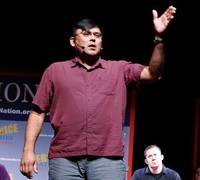 Each of Darwin’s finch species had a bill adapted to its diet, with short and long beaks allowing different finches to eat different parts of the prickly pear. But what if the crew of Darwin’s ship, the Beagle, had introduced the birds to a nonnative diet like, say, CornNuts?
Each of Darwin’s finch species had a bill adapted to its diet, with short and long beaks allowing different finches to eat different parts of the prickly pear. But what if the crew of Darwin’s ship, the Beagle, had introduced the birds to a nonnative diet like, say, CornNuts?
Josh Snodgrass, assistant professor of anthropology, is working on the hypothesis that the introduction of a novel diet can actually influence how we evolve. He’s especially interested in how the modern human diet—based on industrialized food high in sugar, salt and fat—is meshing with our genes. His research is focusing on indigenous cultures that are relative newcomers to Fast Food Nation.
“People seem to think that once we stopped being hunter-gatherers and developed a more stable means of sustaining ourselves that evolution just stopped working on us,” Snodgrass said. “But that’s hardly the case.”
 Two cultures he has studied—the Shuar people in Ecuador’s Amazon and the Yakut (Sakha) horse herders of Siberia—have only in the past decade started eschewing the traditional life and transitioning into a modern one, complete with a more Western diet. As evidence, Snodgrass shows photos of a grocery store from Siberia, where the people traditionally herded cattle and reindeer. The store’s shelves are stocked with glossy packages of Cheetos, potato chips and Nestlé chocolate mix (right). On an adjacent shelf is a paltry collection of meager fruits and vegetables (below).
Two cultures he has studied—the Shuar people in Ecuador’s Amazon and the Yakut (Sakha) horse herders of Siberia—have only in the past decade started eschewing the traditional life and transitioning into a modern one, complete with a more Western diet. As evidence, Snodgrass shows photos of a grocery store from Siberia, where the people traditionally herded cattle and reindeer. The store’s shelves are stocked with glossy packages of Cheetos, potato chips and Nestlé chocolate mix (right). On an adjacent shelf is a paltry collection of meager fruits and vegetables (below).
Snodgrass’s ability to track these populations in real time as they have transitioned from one diet to another is starting to provide intriguing insights as to how the human diet intermingles with physiology and genetics.
 “The Siberians seemed to have evolved to have a high metabolic rate to help deal with the extreme cold,” he said. “But just in the last five years we’ve seen a drop in their metabolic rate, an increase in their obesity rate as well as preliminary indicators for diabetes.”
“The Siberians seemed to have evolved to have a high metabolic rate to help deal with the extreme cold,” he said. “But just in the last five years we’ve seen a drop in their metabolic rate, an increase in their obesity rate as well as preliminary indicators for diabetes.”
Of course, the introduction of less healthy, nontraditional foods is happening in many places, but Snodgrass says there’s evidence the medical effects vary from community to community, quite possibly because of genes. Something about the Siberians’ genetic makeup, for example, seems to predispose them to hypertension and stroke with a more salt-rich and carb-heavy diet.
In Ecuador, the Shuar people had long lived as hunter-gatherers, hunting monkeys and foraging for other foods available in a land known for its prodigious biodiversity. Now many villagers are eating primarily rice, pasta and other carbohydrate-rich foods instead of their traditional high-protein diet. Snodgrass’s research has found increasing levels of infectious diseases such as malaria and respiratory illnesses. However, other variables that result from development, such as deforestation and sanitation problems, may play as much a role as the diet.
Whatever the causes may be, Snodgrass hopes his research results will eventually be used by the local community to adopt healthier lifestyles. “In Ecuador, it could be as simple as making sure kids have eggs to eat or raising awareness about the importance of exercise,” he said.
The task for Snodgrass is to take the mountain of data being collected through interviews and health clinic surveys and figure out how all these factors are interrelated. There are some scientists who wonder if perhaps returning to a Paleolithic diet would be the healthiest strategy for all of us, but Snodgrass is looking for simpler short-term solutions.
“Our focus is to understand what this dietary transition means to health and then advocate public policies that can make things better,” he said.
— Marc Dadigan
Photos by Josh Snodgrass




 Learn how experts across disciplines are together advancing green chemistry.
Learn how experts across disciplines are together advancing green chemistry.